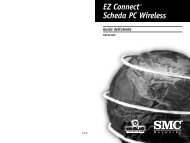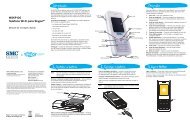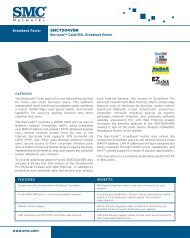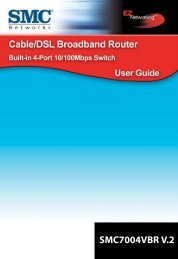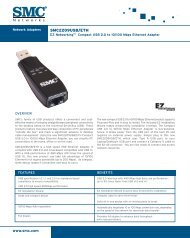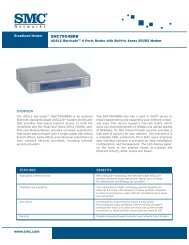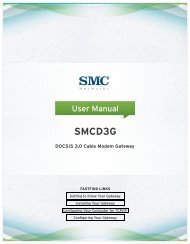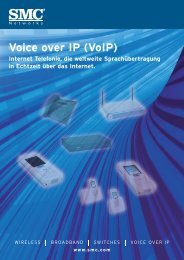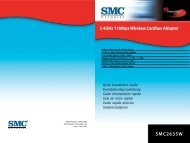PRODUCT CATALOG - SMC
PRODUCT CATALOG - SMC
PRODUCT CATALOG - SMC
You also want an ePaper? Increase the reach of your titles
YUMPU automatically turns print PDFs into web optimized ePapers that Google loves.
UPNP (UNIVERSAL PLUG AND PLAY)<br />
Standard that uses Internet and Web protocols tenable<br />
devices such as PCs, peripherals, intelligent appliances,<br />
and wireless devices to be plugged into a network and<br />
automatically know about each other. With UPnP, when a<br />
user plugs a device into the network, the device will<br />
configure itself, acquire a TCP IP address, and use a<br />
discovery protocol based on the Internet's Hypertext<br />
Transfer Protocol (HTTP) to announce its presence on the<br />
network to other devices.<br />
USB (Universal Serial Bus)<br />
Plug-and-Play interface between a computer and<br />
add-on devices (such as audio players, joysticks, keyboards,<br />
telephones, scanners, and printers). With USB, a new<br />
device can be added to your computer without having to<br />
add an adapter card or even having to turn the computer off.<br />
UTP<br />
Unshielded twisted pair cable.<br />
VDSL (VERY HIGH SPEED DIGITAL SUBSCRIBER LINE)<br />
Supports exceptionally high-bandwidth applications such as<br />
High-Definition Television (HDTV). It is not as widely<br />
deployed as other forms of DSL service. However, VDSL<br />
can achieve data rates up to approximately 51.840 Kbps,<br />
making it the fastest available form of DSL.<br />
VF45<br />
Small form factor fiber connector.<br />
VIRTUAL SERVER<br />
Presents a single address that represents an application<br />
server farm to clients.<br />
VLAN (Virtual LAN)<br />
A network of computers that behave as if they are<br />
connected to the same wire even though they may be<br />
physically located on different segments of a LAN.<br />
VOIP (VOICE-OVER-IP)<br />
The ability to transmit voice data over LAN/WAN TCP/IP<br />
networks.<br />
VPN<br />
Virtual Private Network. A network that is constructed by<br />
using public wires to connect nodes.<br />
WAN (WIDE AREA NETWORK)<br />
Wide area networks can be made up of interconnected<br />
smaller networks spread throughout a building, a state, or<br />
the entire globe.<br />
WEP (WIRED EQUIVALENT PRIVACY)<br />
All IEEE 802.11b (Wi-Fi) networks use WEP as their basic<br />
security protocol. WEP secures data transmissions using<br />
64-bit or 128-bit encryption.<br />
WI-FI (WIRELESS FIDELITY)<br />
Wi-Fi originally referred to the IEEE 802.11b specification<br />
for WLANs, but it is now used to describe any of the IEEE<br />
802.11 wireless networking specifications.<br />
WIRELESS BRIDGE<br />
Wireless Bridge is an alternative to connecting two<br />
or more separate LANs with cable. With a Wireless Bridge<br />
you gain wireless connectivity between two or more<br />
remote LANs.<br />
WIRELESS LAN<br />
A local area network that uses high frequency radio<br />
waves rather than wires to communicate between nodes.<br />
SUPPORT & SERVICE<br />
GLOSSARY<br />
46<br />
WOL (WAKE-ON-LAN)<br />
With a Wake-on-Lan connection client systems can<br />
be remotely and automatically powered up.<br />
WORKGROUP<br />
Two or more individuals who share files and databases.<br />
LANs designed around workgroups provide electronic<br />
sharing of required data.<br />
WORKSTATION<br />
(1) High performance, single user microcomputer or<br />
minicomputer that has been specialized for graphics,<br />
CAD, CAE or scientific applications. Typically comprised<br />
of high resolution screens, local graphics processing,<br />
keyboard, pointing device, and network connection.<br />
(2) In a LAN, a personal computer that serves a single<br />
user in contrast with a file server that serves all users<br />
in the network.<br />
(3) Any terminal or personal computer.<br />
WPA (WI-FI PROTECTED ACCESS)<br />
Specification for improving the security of Wi-Fi<br />
networks, replacing WEP for current and future IEEE<br />
802.11 standards. It uses IEEE 802.1x and EAP to restrict<br />
network access, and it uses its own encryption, called<br />
Temporal Key Integrity Protocol (TKIP), to secure data<br />
during transmission.




